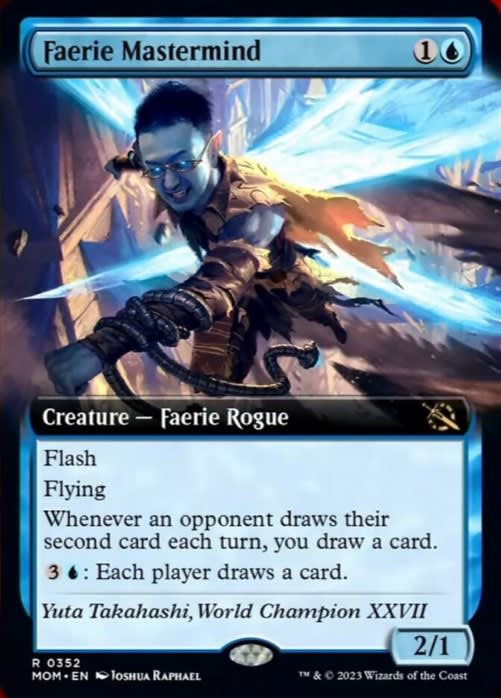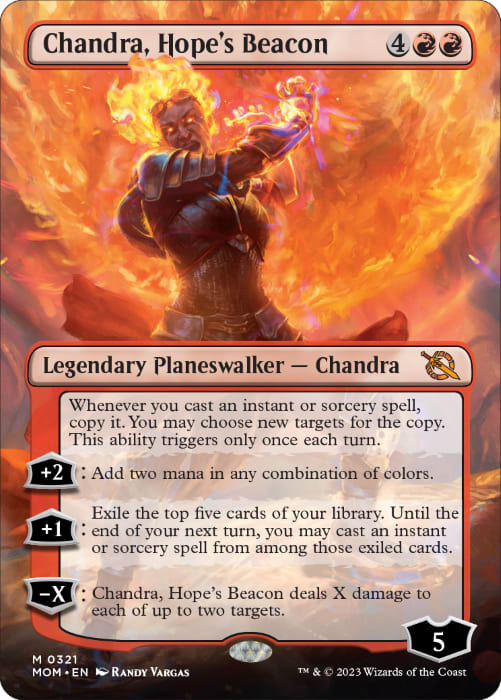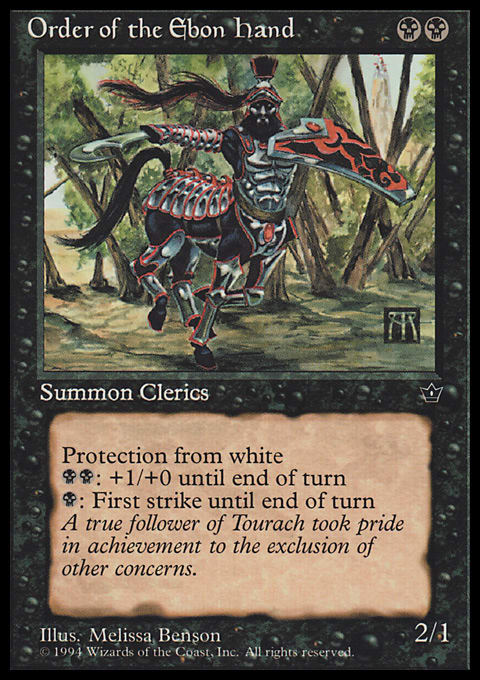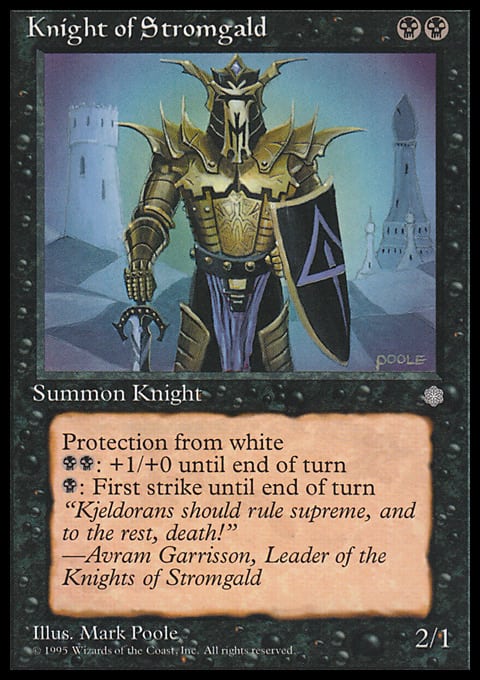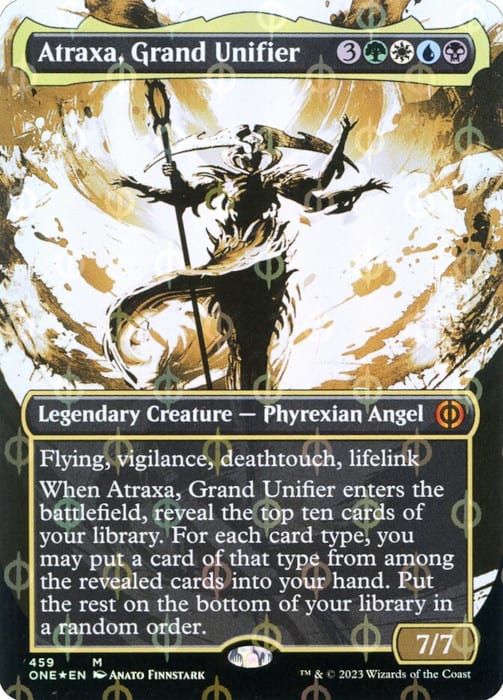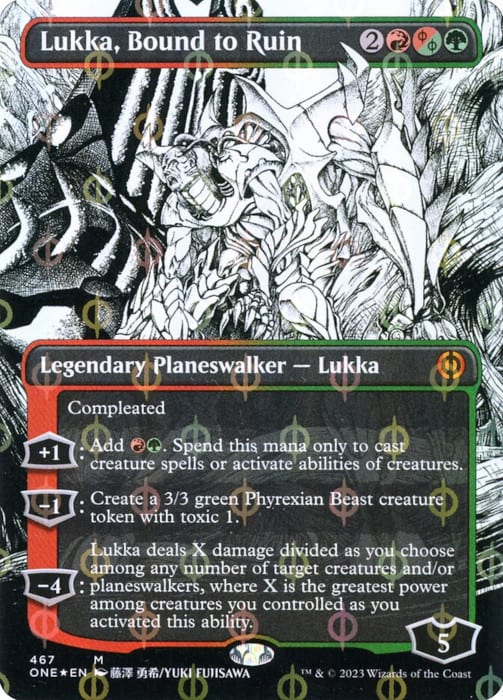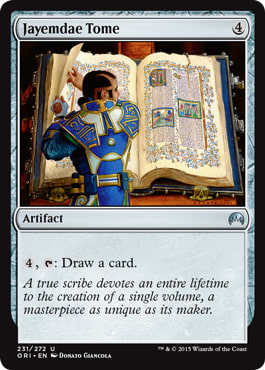I'm barely used to how cards like Skrelv, Defector Mite have rewritten the rules of engagement for Standard and, lo and behold, there are spoilers for yet another upcoming Standard-legal set.
This one was unveiled during live PT coverage. The best part of the story was when World Champion Yuta Takahashi, Faerie Mastermind's designer, said that he originally wanted it to be 1/3 instead of 2/1.
As a "Flash" creature this would have allowed Faerie Mastermind to jump onto the battlefield mid-combat... Ideally when the opponent had their mana tapped for a dashing Mythic Monkey. I guess he'll have to settle for having a card - any card really - that can answer Ragavan, Nimble Pilferer one-for-one instead of eating it outright and leaving a draw engine behind.
The 1/3 version was deemed too strong. Let's hope the 2/1 version, with its flying and almost built-in capability to hold a lead, isn't too oppressive of a clock in non-Ragavan formats.
Today I really just want to talk about Yuta's March of the Machine set-mate, Chandra, Hope's Beacon.
Planeswalkers have been a mixed bag for Magic.
Boomers of my generation largely think they've been bad for the game as a whole. From a skill standpoint it's easy to see why. Planeswalkers double down - triple down, really - on shifting expectation from a human player's hands to the cardboard those hands draw and use each turn.
In the old days, the best cards were spells like Lightning Bolt, Dark Ritual, or even Ancestral Recall. While some individual effects were very powerful, having the best cards be spells made them essentially limited. A Lightning Bolt is great, but you can only spend it once. A Dark Ritual can potentially put you far ahead early in the game, but it also puts you behind on cards in hand.
Increasingly WotC R&D has tried "to make creatures good" and over time they succeeded not only in making creatures much, much better than spells for the most part... The mandate moved to other permanents as well. The knock on this trend is that it has made the game far less skill-intensive. In the past you had to think about whether you wanted to point Lightning Bolt at the opponent or one of the opponent's creatures: You only got one, and the decision mattered. Creatures can be used over and over, so are less punishing of mistakes. Even when you do screw up and lose one, that loss usually resulted in a trade, possibly a favorable trade. Planeswalkers though... We'll get to Planeswalkers in a minute.
There was a time that this was the most fearsome offensive creature in competitive Magic. Randy Buehler, then the head of WotC R&D, would argue that despite Jackal Pup's drawback, it was simply better than Savannah Lions because Red was so good at getting it through blockers whereas Savannah Lions would consistently be left home; especially in the age of Protection from White Pump Knights.
It's hard for contemporary players to wrap their heads around how good Jackal Pup was (unless they become fans of Premodern coverage), because creatures have gotten out of control even from that lordly base. To be clear: Jackal Pup was good. It was the scariest thing that someone might play. No one respected the version without a drawback, but everyone's teeth chattered hoping that a Wasteland or Rishadan Port was not the turn two follow up.
Jackal Pup, at least, was a Baneslayer Angel. That is, it was a creature whose value was in the creature itself.
Over time, good creatures - even good aggressive creatures - have moved more from the Baneslayer Angel side of the world to the Mulldrifter side. They are nominally, technically, "creatures" ... But they either act like spells or have spells tacked onto perfectly good bodies. We call the latter Titans.
Until very recently, Llanowar Visionary was my go-to example of a Titan. Because you draw a card when it enters the battlefield, Llanowar Visionary qualifies as a Mulldrifter. But It's value in play is less as a 2/2 body (though there is some there) and more for its mana production. You actually want it for its body at some level. Since it's already a Mulldrifter you can't really call it a Baneslayer Angel; hence, Llanowar Visionary is a Titan.
Of course, today there is a better example:
Heck of a body, several different ways. Very Baneslayer-like. Plays offense and defense simultaneously. Atraxa is even an Angel! But, of course, drawing seven cards when she enters the battlefield puts this Phyrexian Angel into another category entirely. Titan.
Planeswalkers - the good Planeswalkers at least - shift the value from spells to creatures permanents even further. Every time I play a Bloodtithe Harvester and my opponent Cuts it Down I make a mental note: "Card for a half-card" ... I might have lost the Harvester, but a decent chunk of the card's value was in the Blood Token, and I still have that.
Many Planeswalkers have a "card for a half-card" default setting. In some cases you even get more than one!
The classic is Liliana. You drop her. She uses her [-2] ability. In Magical Christmas Land you just ate a Graveyard Trespasser // Graveyard Glutton without triggering its nasty Ward... And you've got a loyalty to spare. You used half - okay maybe two-thirds - of your Liliana but got a full card. This design type is exactly why so many boomers dislike Planeswalkers by the way.
The new Lukka is even cooler! You might use four-fifths of Lukka, but you not only get to keep one loyalty (which, at the low end of the range, is still a 3/3 Phyrexian Beast)... But you might get to destroy more than one creature on the way.
It's from this flavor that I want to start with Chandra's third ability:
Imagine the rattiest version of Chandra you can. You pay six. You go [-5] and point five at the opponent. You don't even choose a second target. Congratulations! This is essentially the effect of a Blaze variant for the cost of a Blaze variant. That puts Chandra in a rare place, efficiency-wise.
Remember, one target and all of Chandra is the worst way we can slice this cake. How about [-4], you get to eat their Bloated Contaminator, and you still have a loyalty counter? How about [-2], you kill two things, and you don't trigger Rotpriest?
To me the important thing is how mana efficient Chandra's [-X] is. One target at five damage has cost six since the mid-1990s. This. Costs. Six.
I wanted to start there because five loyalty pointed at one target is one of the few ways you can fail to gain card advantage with Chandra. Even four loyalty at one target is going to leave you with a much better permanent than a Blood Token. It is the opposite of historical Magic design. It's like getting a Blaze for four... Only the Blaze didn't go to the graveyard. For a whopping zero mana next turn, you can make 2 mana or draw a bunch of cards! It is easy to see how not-punishing resource flubs with Planeswalkers can be. Even if you chose the next-to-rattiest version of a [-X], you still have value to play with. This annoys the bejeezus out of boomers.
The cool thing about Chandra is that she has four abilities, and many of them work together (even if only three are Loyalty abilities). The acid test for most Planeswalkers is whether they can protect themselves. Chandra can protect herself at least two ways. The first one is obviously [-X]. The opponent had better have more than two creatures with more than 4 toughness or you're in good shape to untap with Chandra, given [-X].
[+2] is subtly also a good self-protection capability, and card advantageous!
The danger, theoretically, is tapping out for a big Planeswalker like Chandra. For some Planeswalkers, they just have to rely on the board being empty or fat Loyalty in the bottom-right for survival. But what if you have any removal spell? Bounce spell? Chandra can not only cast literal BOOMERANG for you if you want... You get two of them.
[+1]: Exile the top five cards of your library. Until the end of your next turn, you may cast an instant or sorcery spell from among those exiled cards.
People tend to want to know how a Planeswalker will obtain card advantage for them if it sticks around. After the acid test of whether they can protect themselves, this is usually where analysis of a new Planeswalker moves next. It is also the extremity of contemporary card design. Not only have we moved from spells to creatures (or permanents generally)... Now we have permanents that cast spells.
And not only do they cast spells - this is where Planeswalkers are so warping - they do so for no mana.
How much would you pay to dig five deep for an instant or sorcery? The answer is ![]()
![]() . Jace Beleren drew a card. Jace, the Mind Sculptor Brainstormed every turn. Those cards would have cost essentially
. Jace Beleren drew a card. Jace, the Mind Sculptor Brainstormed every turn. Those cards would have cost essentially ![]() . In Beleren's case you lost Loyalty and in The Mind Sculptor's you at least stayed even. Chandra, Hope's Beacon prints
. In Beleren's case you lost Loyalty and in The Mind Sculptor's you at least stayed even. Chandra, Hope's Beacon prints ![]()
![]() while gaining Loyalty.
while gaining Loyalty.
But.
That's.
Not.
All!
When you get your instant or sorcery, what happens next? Chandra's Always Active ability kicks in! Every instant or sorcery you cast can potentially be two cards. Chandra's [+1] saves you ![]()
![]() every turn, puts a Loyalty on your Planeswalker, and essentially gets you two cards.
every turn, puts a Loyalty on your Planeswalker, and essentially gets you two cards.
We are a far, far cry from Weissman's signature tool (still the most fearsome card drawing engine in Old School):
So, after all this I must thing Chandra, Hope's Beacon will be the best card in Standard, right? Overpowered in every way my generation hates. A card advantage engine that makes mana and protects itself at least two different ways. Heck, if all you did was rack up Loyalty - and either real or virtual mana [value] every turn - Chandra would easily kill the opponent for you.
Yet... I'm not even sure.
Chandra costs six.
Six is a ton.
Not only is six a ton, Chandra would often not be the best permanent in play! The Eternal Wanderer also costs six, and it's a pretty good card. It might be painful, but The Eternal Wanderer can hold off Atraxa.
I want this card to be good.
I'm excited to try it!
But I'm not actually sure it will be better than the new Koth:
Koth sees most of its play right now in the sideboard of beatdown decks, and I love Love LOVE that for him! He also costs two less than our favorite Pyromancer.
But we can only Hope ['s Beacon].
LOVE
MIKE
















